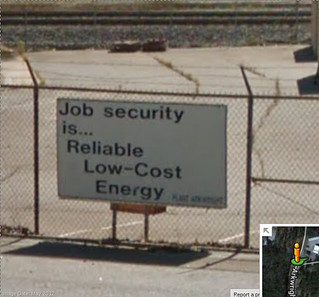Penny-wise, pound foolish, that's coal and coal ash, we're all discovering.
S. Heather Duncan wrote for the Macon Telegraph 14 April 2012, Plant Scherer ash pond worries neighbors as Georgia Power buys, levels homes,
The home among the trees was supposed to be Mark Goolsby's inheritance. His 78-year-old mother now lives in the large, white, wood farmhouse that his family built before the Civil War.
But Goolsby says he'll never live there now.
 That's because across the street and through those trees is one of the largest coal ash ponds in the country. It belongs to Plant Scherer, a coal-fired plant that came to the neighborhood considerably later than the Goolsby family. In the mid-1970s, Goolsby said, “when (Georgia Power) bought 350 acres from my dad, they told him we'd never know they were there.”
That's because across the street and through those trees is one of the largest coal ash ponds in the country. It belongs to Plant Scherer, a coal-fired plant that came to the neighborhood considerably later than the Goolsby family. In the mid-1970s, Goolsby said, “when (Georgia Power) bought 350 acres from my dad, they told him we'd never know they were there.”
Those acres are now part of an unlined pond where Georgia Power deposits about 1,000 pounds of toxic coal ash a day. Neither federal nor Georgia rules require groundwater monitoring around the pond. The federal Toxic Release Inventory shows that in 2010 alone, the pond received ash containing thousands of pounds of heavy metals and radioactive compounds including arsenic, vanadium, and chromium.
The U.S. Environmental Protection Agency estimates that up to 1 in 50 residents nationally who live near ash ponds could get cancer from the arsenic leaking into wells. The EPA also predicts that unlined ash ponds can increase other health risks, such as damage to the liver, kidneys and central nervous system, from contaminants such as lead.
A massive 2008 spill from a Tennessee coal ash pond led to greater scrutiny of the dams that hold these ponds in place, and the EPA promised new rules for storing coal ash. The process led to broader awareness of a more long-term health threat: groundwater contamination from the ponds.
So what's Georgia Power's solution?
Monroe County property records show Georgia Power has spent about $1.1 million buying property near Plant Scherer between 2008 and the end of 2010. But the true number may be higher.
They're going to have to keep doing that until they buy up a lot more property, I predict.
Wouldn't it be cheaper for the future bottom line of Georgia Power and its parent the Southern Company to invest in solar and wind power?
-jsq
 According to
Georgia Power’s own online history:
According to
Georgia Power’s own online history:


